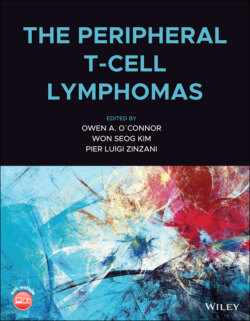Читать книгу The Peripheral T-Cell Lymphomas - Группа авторов - Страница 29
Crosstalk Between Neoplastic T Follicular Helper Cells and Their Microenvironment in Angioimmunoblastic T‐cell Lymphoma
ОглавлениеThe cellular derivation of AITL from Tfh cells provides a rational model to explain the formation of the characteristic AITL microenvironment. Tfh cells represent a distinct functional subset of effector T‐helper (Th) cells, which normally reside in germinal centers where critical interactions with germinal center B cells promote B‐cell survival, immunoglobulin class‐switch recombination and somatic hypermutation, ultimately yielding high‐affinity plasma cells and memory B cells [62].
On tissue sections, a close contact is observed between neoplastic AITL cells, FDCs and B cells, the three important key players in the disease (Figure 2.2). Large B immunoblasts, often infected by EBV, interact with neoplastic Tfh cells, as exemplified by the rosettes of neoplastic Tfh cells often seen around B‐cell blasts. These interactions are mediated by ligand‐receptor pairs expressed on the membrane (such as ICOS‐ICOS‐L and CD40‐CD40L) and cytokines/chemokines secretion. CXCL13 secreted by neoplastic Tfh cells is likely a major mediator that can promote B‐cell expansion and plasmacytic differentiation. In addition, CXCL13‐producing FDCs could also interact with neoplastic Tfh cells which express CXCR5, resulting in localization of these cells to the germinal center [63]. Lymphotoxin beta, also expressed in AITL tumor cells [64], might be involved in inducing FDC proliferation. Interleukin (IL) 6 produced by Tfh cells and myeloid cells can promote plasma cell proliferation [65]. IL21, the major cytokine secreted by Tfh cells, exhibits an autocrine effect on the IL21‐positive Tfh, and also exerts positive effects on B cells. The role of VEGF and its receptor, both expressed by neoplastic and endothelial cells in AITL, has been proposed in promoting vascularization observed in the disease. A number of chemokines, like CCL17/TARC, or cytokines such as IL4, IL5, and IL13 demonstrated in CD3+ T cells isolated from AITL lymph nodes, are potential mediators of eosinophilic infiltrate in tissue biopsies and/or eosinophilia [66]. AITL also comprises a variable number of macrophages, with various phenotypes and functions [67].
Variation in microenvironment may have prognostic relevance, reinforcing its role in lymphomagenesis. Tissue infiltration of CD163‐positive macrophages has been shown to associate with worse prognosis in patients with AITL, suggesting their importance in AITL [67]. A depletion of Treg cells and an expansion of CD163 macrophages together with an accumulation of Th17 cells reported in AITL tissues could contribute to the proinflammatory and immunosuppressive microenvironment in AITL [68]. Gene expression studies identified molecular signatures associated with outcome [69, 70]. For example, The B‐cell‐associated signatures predicted favorable outcome, whereas monocytic, cytotoxic (associated with CD8 + T cells) and p53‐induced target gene signatures were associated with poor outcome [70].
